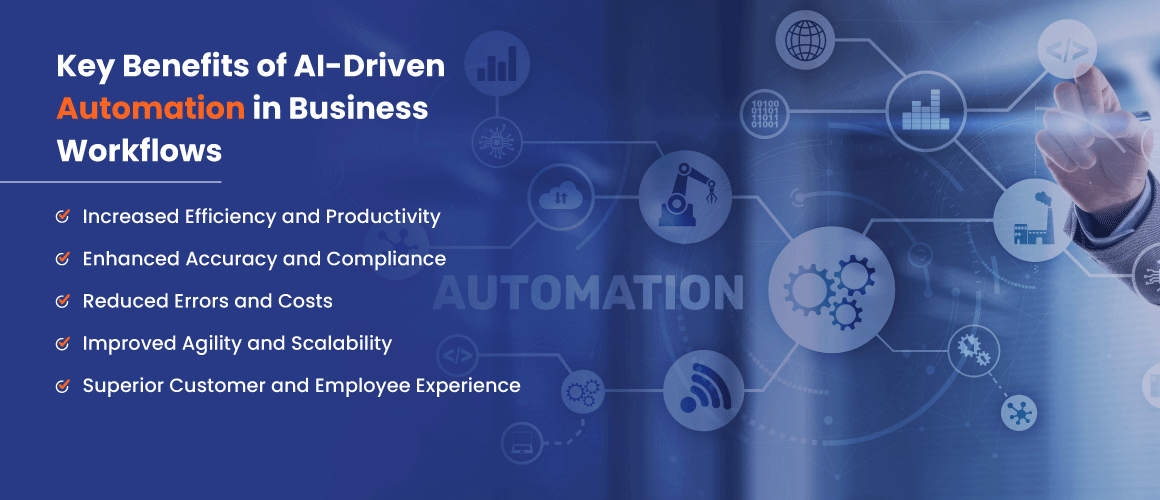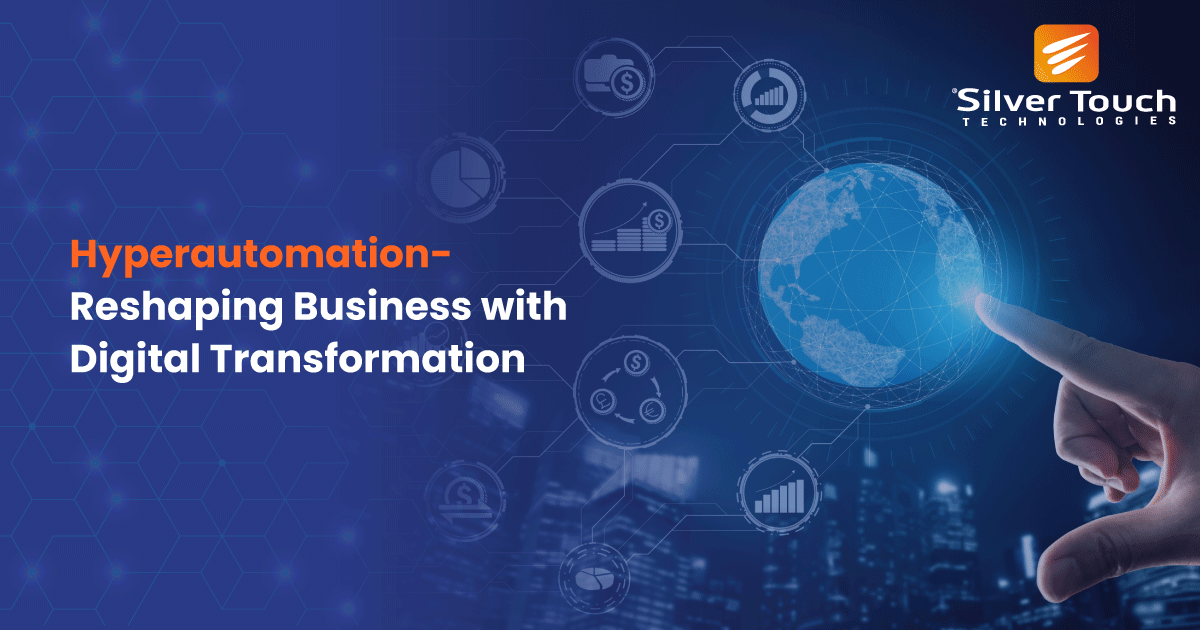Today’s highly challenging and competitive scenarios keep businesspeople on their toes. They strive to maintain efficiency, agility, and quality to stay ahead of the curve. This requirement has made digital transformation a compelling necessity for modern businesses. Hyperautomation, the future of automation, has gained prominence in recent times for transforming processes digitally.
As a fusion of cutting-edge technologies like AI, Robotic Process Automation (RPA), and advanced analytics, hyperautomation acts as a strategic approach these days. This combination of emerging technologies enables businesses to leverage the advantage of intelligent automation. This blog will delve into the importance and real-time applications of hyperautomation.
Before moving ahead, let’s understand the role of technologies in making hyperautomation a reality.
Technologies behind Hyperautomation
Artificial Intelligence, RPA, and Advanced Analytics act as three pillars in the foundation of hyperautomation. Each of these concepts has distinct roles to play, but they enable the intelligent automation of complex business processes.
Here is a detailed account of all three technologies and their roles in hyperautomation-
AI (Artificial Intelligence)
It acts as an “intelligent layer” in hyperautomation. As a strategic conductor, AI can bring the capacity to think, learn, and adapt in business process automation. Whether it is decision-making or pattern recognition, Artificial Intelligence can act effectively at every stage.
Moreover, capabilities like NLP (Natural Language Processing) assist AI in driving cognitive automation for enabling systems to process and understand unstructured data.
RPA (Robotic Process Automation)
It establishes the foundational digital workforce within hyperautomation. It can automate repetitive and rule-based tasks with high speed and accuracy. Here, software bots can mimic human interactions with digital systems to perform mundane tasks like data entry and form filling.
RPA plays a crucial role in hyperautomation as it lays the ground for the next level of automation by handling high-volume, time-consuming activities. It makes human workers free to focus on strategic initiatives.
Advanced Analytics
It is a critical insight engine for hyperautomation as it offers data-driven intelligence. Advanced analytics can deliver actionable insights that inform, validate, and improve automated processes. Organizations can identify inefficiency and bottlenecks with the help of these insights.
Furthermore, advanced analytics is useful to get predictive insights related to future trends for strategy optimization. Hyperautomated or intelligent systems can tailor customer experiences and operational responses based on data analysis.
In all three pillars, AI remains at the core of intelligent automation. Let’s dig deep into the role of AI-driven automation in modern businesses.
How AI-Driven Automation Streamlines Business Operations
AI-driven hyperautomation focuses on end-to-end optimization of business processes spanning multiple departments and systems. It can create interconnected and self-improving workflows by combining with RPA and advanced analytics. As a holistic approach, it ensures the removal of inefficiency at every level to create a highly optimized automated ecosystem.
Here are the benefits of AI-powered automation through streamlining business operations-

Increased Efficiency and Productivity
Automation of complex and multistep workflows can reduce cycle times and eliminate bottlenecks to increase the overall efficiency and productivity.
Enhanced Accuracy and Compliance
AI-driven automated processes operate with high precision, eliminating the risk of human errors. It ensures consistence adherence to prevalent regulations.
Reduced Errors and Costs
Minimal dependence on manual interventions and optimized resource allocation can save money and reduce the chances of errors significantly.
Improved Agility and Scalability
Automated operations can easily adapt and scale as per business requirements. It gives a high agility to modern businesses for changing market trends.
Superior Customer and Employee Experience
Employees can get rid of repetitive and mundane tasks, whereas customers get quicker service delivery with personalized interactions to improve experiences.
Let’s go through some real-time use cases of hyperautomation to understand these benefits effectively.
Real-Time Applications of Hyperautomation
Hyperautomation has the transformative power on various business functions across all departments. Companies can achieve high efficiency and scalability while delivering superior outcomes in critical areas like finance, customer service, etc. Here are three real-world applications of hyperautomation-
Finance
Business process automation is useful for the finance department in handling high volumes of repetitive tasks without compromising on accuracy and compliance.
Thankfully, hyperautomation enables the finance department in handling such tasks related to invoice processing, fraud detection, and financial reporting. AI, analytics, and RPA bots can manage it properly.
Hyperautomation can streamline report generation and compliance effectively. RPA bots can automate the data collection from disparate systems, while AI can validate and structure this data to generate accurate reports. It minimizes human intervention and adheres to stringent regulations.
HR
Intelligent automation can reduce the burden on the HR department and enable HR executives to focus more on strategic talent management. RPA bots can automate the process of generating necessary documents during onboarding and offboarding. AI can analyze employee profiles and recommend personalized training modules.
In payroll processing, RPA can calculate salaries and deductions effectively while automating the disbursal of funds. It can remove human errors and ensure timely payments.
AI can revolutionize the initial stages of the interview and identify candidates with identical skills and experiences. It works with RPA bots for sending notifications and managing communications with candidates.
Customer Services
Personalized experiences, faster resolutions of queries, and enhanced satisfaction are three key impacts of hyperautomation in customer services.
Chatbots and virtual assistants, powered by AI, can handle a vast majority of routine inquiries on a 24x7 basis. They can provide customers with instant answers to FAQs and guide them through self-service options.
For resolving complaints, AI can analyze customer sentiment in real-time with the help of advanced analytics and set urgency or priority for complaints. RPA bots then assist customers by shifting these complaints to the right department with automated follow-up communications.
It is interesting to have a glimpse of the future of hyperautomation.
Future of Hyperautomation
We can expect the advent of highly sophisticated and pervasive integration of intelligent technologies. As a result, hyperautomation will move beyond the current capabilities of handling organizational structures and business models.
A deeper focus on IPA (Intelligent Process Automation) will result in a seamless interaction of AI’s cognitive abilities with RPA and advanced analytics. It will automate end-to-end, knowledge-intensive processes.
Moreover, we can witness the future of automation as a convergence of additional technological advancements like LCNC (Low Code- No Code) and process mining.
Finally, we may see the most successful implementations of hyperautomation solutions that foster a smooth relationship between humans and intelligent machines. It will create a highly augmented workforce in the coming years.
Concluding Lines
Hyperautomation is a beneficial approach that involves AI, robotic process automation, and advanced analytics to take automation to a new level. Various departments, including HR and finance, can leverage the benefits of this combination of future-ready technologies. It is, however, necessary to keep several considerations in mind while implementing hyperautomation into the business system.
We, at Silver Touch, assist modern businesses in driving digital transformation by providing hyperautomation solutions. Our in-house team of experienced professionals can combine AI, RPA, and advanced analytics in intelligent automation solutions. Contact us to learn more about the future and scope of hyperautomation for your company.
FAQs
What is hyperautomation in business?
Hyperautomation is a strategic approach that combines technologies like AI, Robotic Process Automation (RPA), and advanced analytics to automate complex business processes end-to-end.
How does AI contribute to hyperautomation?
AI acts as the intelligent layer in hyperautomation, enabling decision-making, learning, and cognitive automation through capabilities like Natural Language Processing (NLP).
What are the benefits of AI-driven hyperautomation?
Key benefits include improved efficiency, reduced costs, enhanced accuracy, better compliance, and personalized customer and employee experiences.
How is hyperautomation used in the finance and HR departments?
In finance, it automates tasks like invoice processing and reporting. In HR, it streamlines onboarding, payroll processing, and candidate screening.
What does the future of hyperautomation look like?
The future will see deeper integration with technologies like Intelligent Process Automation (IPA), Low-Code/No-Code platforms, and process mining—leading to highly augmented workforces.
